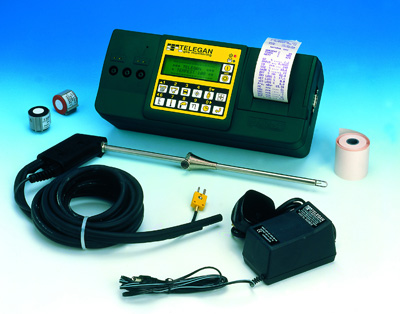Home › Gas Analysers › Boiler/Flue › Flue Gas Analysers Guide
What is a Portable Flue Gas Analyser?
A portable electronic device, a flue gas analyser measures and displays the products of combustion from both domestic and commericial fossil fuelled appliances. Additionally, they can measure the ambient air quality in rooms or buildings.
Using a Flue Gas Analyser
Flue Gas Analyers should be used for the following two purposes:
Domestic Boilers and Hot Water Heaters
Flue gas analysers usually display a CO/CO2 ratio. This shows the ratio of carbon
monoxide and carbon dioxide in the exit flue (chimney) of the appliance. Ambient Air Monitoring
Your analyser will monitor ambient levels of CO in any room. This is carried out by first
switching the analyser on in fresh, outdoor air to set its' zero value, following the
manufacturer's instructions. You should then take the analyser into the room to be
monitored.Flue Gas Analysers Guide
If you are a domestic or commercial service engineer, responsible for installation, management and maintenance, you should always use a flue gas analyser.
This article briefly explains the purpose of analysers, what they can be used to do and also the understanding of the information they display. Please remember that this is not a substitute for regulations applying currently or a substitute for regular servicing of appliances.
Appliance testing
A Flue gas analyser measures flue gases - You place its' probe in the chimney or
appliance exhaust and see what levels of Oxygen (O2), Carbon Monoxide (CO),
Carbon Dioxide (CO2) and flue gas temperatures are present.
They are no more
complicated to operate than a video camera and perform a similar function as they are
your "eyes" inside the appliance. Some analysers offer additional information such as
boiler efficiency, data logging, differential pressure and other gas measurements. They
should also offer the option to either print or store the measurements for later review.
Ambient air monitoring
A Flue gas analyser also measures room air, provided it has been switched on or
"calibrated" in fresh, outdoor air. This is invaluable, for example, when trying to find out
whether there is CO leaking from an appliance or pinpointing why a CO alarm is being
triggered.
Appliances such as boilers, heaters, fires and cookers are like vehicle engines, mixing
air and fuel and creating products of combustion. If these products, such as Carbon
Monoxide "the Silent Killer", are not safely removed they can kill or injure people. Using a
flue gas analyser lets you check this is happening both safely and efficiently.
This is important because Carbon Monoxide, a colourless, odourless and tasteless gas,
is responsible for killing over 50 people a year, mainly from poorly installed or serviced
appliances.
Here is a guide to understanding the results from testing appliances with a flue gas
analyser:
Generally when this level is below 0.004 the boiler is considered to be running
efficiently. When between 0.004 and 0.008 this indicates a potential problem and
investigation and retesting must take place. When above 0.008 the appliance must be
fully investigated, cleaned and retested.
Please note that this is not applicable to all boiler and heater types, especially those
using oil or solid fuel. However, if the CO level in the flue of a gas appliance is above
100ppm (parts per million) then an investigation must take place. For oil or coal fired
appliances the CO should not be above 200ppm.
Equally, Oxygen (O2) levels should be in the region of 3-5% for gas appliances and 5 -
8% for oil & solid fuel appliances - Any other levels suggests an inefficient use of energy,wasting fuel and money, or a potentially unsafe situation where too much CO is created
through oxygen deficiency.
Flue Temperatures for gas appliances should be less than 200 degrees centigrade or
less than 300 degrees centigrade for oil and solid fuel appliances.
For Gas Hobs and
Cookers, if CO levels at approx 300mm (12") above the top of the blue flame are above 9 ppm
then there is most likely a problem requiring investigation
Fires
If CO level at approx 300 mm (12") in front of the flame or grate are above 9 ppm then
there is most likely a problem requiring investigation.
You should always use common sense when determining whether there is a problem
and always consult the national regulations that apply when performing appliance
installation and service.

Crowcon Tempest 100 Flue Gas Analyser
If the analyser measures CO levels above 9 ppm, an investigation should be made. Any
reading over 35ppm should prompt immediate action such as opening all windows and
doors, switching off and isolating any appliances present and leaving the room.
A subsequent room retest should be made after each appliance has been checked.
Don't forget that CO levels in rooms can occur from being adjacent to a busy road, car
park or garage, as well as from smokers, outdoor barbeques, adjacent properties sharing
the same flue systems, etc. You should always use common sense when determining
whether there is a problem and always consult the national regulations that apply to you
when performing appliance installation and service.
Finally, whilst every effort is made to ensure accuracy, this document is always subject
to revision as more information becomes available on CO sources and levels and
appropriate testing methods. Consequently we cannot be held liable for any of the
information given above.





